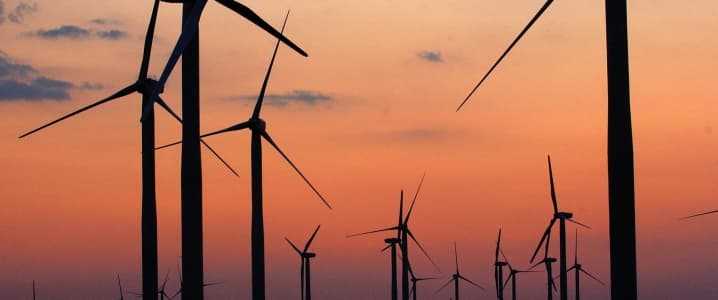A new U.S. Dept. of Energy study shows that the cost of generating more power through wind turbines is cheaper now than buying fuel at an expected price from an equivalent natural gas plant.
That means wind will become even more competitive in capturing more power capacity in coming years with natural gas expected to lose share. Solar power is on the same playing field as wind, and is also expected to see real growth.
The report shows that wind hardware prices are dropping, even as new turbine designs are increasing power generated by each turbine that typical in its usage.
Some of that savings is coming from a tax credit given to renewable energy in the US. That tax credit will be fading out in coming years, bringing uncertainty to the future demand. But, along with solar power, the growth curve has been steady and strong in the US, and that could very well continue.
Wind and solar were very expensive a decade ago, with wind peaking at about $70 per per MegaWatt-hour. That’s been going down, with the average wind prices in power purchase agreements coming in at about $20 per MW-hr for the first time last year.
Solar was much higher — at about $150/MW-hr in 2009. Now those prices for the photovoltaics used in solar are roughly equivalent to wind.
Natural gas prices face the quandary of seeing its production and end-use price going higher than renewables, with wind and solar setting the platform for being the cheapest sources of new electricity in the US. Natural gas is already costing over $20/MW-hr, without even considering the cost of new plants to covert the gas into electricity.
Fossil fuels still dominate US energy generation, making up 63.5 percent of it last year according to the US Energy Information Administration. That broke out to 35.1 percent from natural gas, 27.4 percent from coal, and 0.9 percent from petroleum and other gases. Nuclear was still ahead of renewables, with nuclear power generating 19.3 percent of power last year and renewables coming in at 17.1 percent.
Hydropower still has the other renewables beat, coming in at 7 percent of energy generation last year — compared to wind at 6.6 percent and solar at 1.6 percent. States such as Idaho have tapped into power generated from existing and powerful water sources, especially the Snake River, to produce most of its energy through hydro.
The cost of wind and solar becoming much more competitive will also make electric vehicles more appealing to consumers and fleets concerned about the true cost of owning and operating a vehicle — and thinking about leaving behind their gasoline or diesel vehicle for the first time ever. That also applies to fleets converting over to EVs from natural gas vehicles (NGVs), who take operating costs even more seriously than reducing greenhouse gas emissions.
The incentives had been generous in California, a few other states, and the federal government, for natural gas vehicles to make the cost of buying NGVs, fueling them, and maintaining them, quite competitive with diesel-powered trucks and gasoline-powered light-duty vehicles. Government and private fleets had chosen NGVs over other alternative fuels such as propane autogas, hydrogen, electric, and biofuels.
EVs are starting to see a tipping point reaching fleets across the country, with the incentives remaining strong and the charging infrastructure being deployed rapidly. It helps to see startup and major vehicle makers adding new electric vans, trucks, and buses to their product portfolios.
One of the appeals comes from the fact that the cost of installing EV chargers is drastically lower than building a new natural gas fueling station — or even adding these fuel pumps to existing stations.
The cost of a single port electric vehicle supply equipment (EVSE) unit ranges from $300 to $1,500 for Level 1 chargers, $400 to $6,500 for Level 2, and $10,000 to $40,000 for DC fast charging. A Dept. of Energy study also reported that installation costs range from $0 to $3,000 for Level 1, $600 to $12,700 for Level 2, and $4,000-$51,000 for DC fast charging.
Fast chargers still face the biggest challenge in becoming cost competitive with NGVs and gasoline and diesel stations. Incentives coming from renewable natural gas coming to several stations across the country (with most of it still in California for now) is making NGVs even more appealing to fleets that have to lower carbon emissions.
But NGVs face an even tougher competition for growth in the US market than traditional gas stations. A National Renewable Energy Laboratory report states that a compressed natural gas (CNG) fueling station can range up to $1.8 million depending on the size and application. Smaller fueling units average $10,000, including installation. Liquefied natural gas (LNG) is even more costly, with its fueling sites ranging from $1 to $4 million to establish.
Author: Mohsen Shahvar

